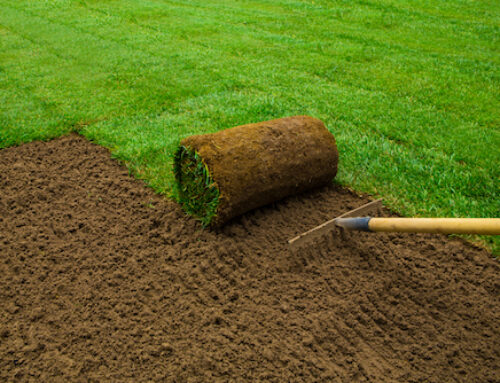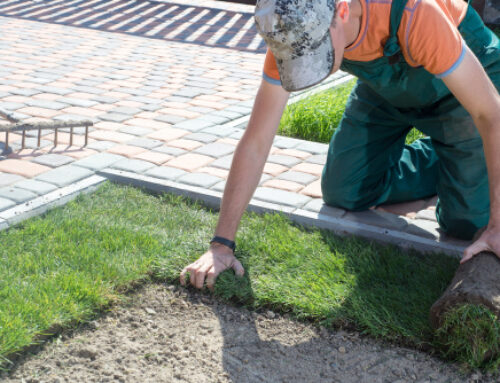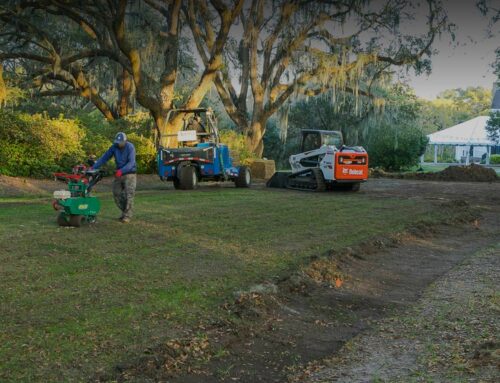Introduction to Golf Course Lawns
A golf course-worthy lawn is the epitome of landscaping excellence, a lush, vibrant canvas that transforms a garden into a masterpiece. This type of lawn, often seen gracing the fairways and greens of golf courses, is characterized by its uniformity, dense turf, and impeccable green hue. The appeal of such a lawn lies in its aesthetic perfection and the sense of tranquility it brings to any outdoor space. It’s not just about the visual pleasure; a golf course lawn symbolizes meticulous care and dedication. Achieving this level of perfection in a home setting involves a deep understanding of grass types, soil health, and precise maintenance techniques. It’s a commitment to excellence beyond ordinary lawn care, turning a simple backyard into a serene retreat that echoes the prestige and beauty of the world’s most renowned golf courses. Here are the tips from sod experts:
Selecting the Right Grass Type
Creating a golf course-worthy lawn begins with selecting the right grass type, significantly influencing the lawn’s health, appearance, and maintenance needs. The ideal grass type for a golf course lawn varies based on several critical factors, including climate, soil type, and the level of care the lawn will receive.
Grasses like Kentucky Bluegrass, Fine Fescue, and Perennial Ryegrass thrive in cooler climates, offering a dense, lush green carpet that can withstand colder temperatures. These varieties are known for their delicate texture and tolerance to moderate foot traffic, making them ideal for creating that manicured golf course look.
Bermuda grass, Zoysia grass, and St. Augustine grass are more suitable for warmer regions. These warm-season grasses are adept at surviving in hot, humid conditions and are known for their ability to recover quickly from damage. They provide a thick, cushion-like turf, perfect for replicating the feel of a golf course.
Soil type also plays a crucial role. Some grasses prefer sandy, well-drained soils, while others thrive in denser, clay-rich soils. Understanding your soil’s composition is vital in choosing a grass type that will flourish in your specific conditions.
Lastly, maintenance requirements are a deciding factor. Some grass types demand more frequent mowing, watering, and fertilization, while others are more low-maintenance. Your willingness and ability to invest time and resources into lawn care will guide you toward the most suitable grass type for your golf course-worthy lawn.
Soil Preparation and Health
The secret to a golf course-worthy lawn lies in the health and preparation of its soil. Healthy soil is the cornerstone of a lush, vibrant lawn, as it supports robust root growth, efficient nutrient absorption, and overall grass vitality. Therefore, understanding and improving your soil’s condition is essential.
Soil health begins with a comprehensive soil test. This analysis provides crucial insights into the soil’s pH level, nutrient content, and composition. Knowing whether your soil is acidic or alkaline, rich or deficient in critical nutrients, guides your next steps in amending it.
Amendments are key to rectifying any imbalances. Lime can be added to acidic soils to raise the pH, while sulfur may be used to lower the pH of alkaline soils. Organic matter, such as compost, is invaluable for enhancing nutrient-poor soils. It improves soil structure, boosts nutrient levels, and enhances moisture retention.
Remember, a lawn is only as good as its soil. Regular testing and careful amendment can transform your soil into a fertile foundation, paving the way for a lawn that mirrors the lush greens of a golf course.
Irrigation and Water Management
Efficient irrigation is pivotal in cultivating a golf course-worthy lawn, promoting profound root growth, and conserving water. Deep root growth is essential for a resilient, healthy lawn; proper watering techniques can significantly influence this.
The key to efficient watering is less frequent but deeper irrigation. This approach encourages grass roots to grow deeper in search of water, resulting in a more drought-resistant and robust lawn. Watering should moisten the soil to about 6 inches, the typical root zone depth of healthy grass.
For best irrigation practices, consider installing an automated irrigation system. These systems can be programmed to water the lawn in the early morning, reducing water loss due to evaporation and wind. Additionally, using rain sensors can prevent unnecessary watering during wet weather.
It’s also crucial to schedule and adjust your irrigation system regularly according to the season and current weather conditions. Over-watering can be as detrimental as under-watering, so monitoring and adjusting your watering schedule to provide just the right amount of moisture for optimal lawn health is essential.
Mowing Techniques for Golf Course Lawns
Mowing is more than just a routine lawn care task; it’s an art that contributes significantly to achieving a golf course-worthy lawn. The key is to master the proper mowing height and frequency and use the right equipment.
For most grass types found in golf course lawns, maintaining a 2 to 3 inches height is ideal. This height helps promote profound root growth and provides enough leaf surface for photosynthesis, which is essential for a healthy lawn. Adjust your mower to this height and avoid cutting more than one-third of the grass blade length at a time to prevent stress on the lawn.
Frequent mowing is also crucial. This might mean mowing once or twice a week during the growing season. Regular mowing encourages lateral growth, creating a denser, more uniform lawn.
As for equipment, using a mower with sharp blades is non-negotiable. Dull edges tear the grass, leading to a frayed and discolored appearance. A reel mower is often recommended for golf course lawns, as it provides a cleaner cut and can be adjusted to low mowing heights, essential for achieving that manicured look. Remember, the proper mowing techniques and equipment are instrumental in sculpting a lawn that rivals the pristine greens of a golf course.
Fertilization Strategies
Fertilization is pivotal in achieving and maintaining a golf course-worthy lawn. Understanding the correct type of fertilizers and their proper timing and application methods is crucial for nurturing a lush, healthy turf.
The first step is to select the appropriate fertilizer. Golf course lawns typically benefit from a balanced blend of nitrogen, phosphorus, and potassium, with nitrogen being particularly vital for promoting lush, green growth. However, the exact formulation should be based on a soil test, which will reveal specific nutrient needs.
Timing is another critical aspect. The general rule for cool-season grasses is to fertilize heavily in the fall and lightly in the spring. For warm-season grasses, the central fertilization should occur in late spring or early summer when the grass is actively growing. This ensures the grass has the nutrients it needs during peak growth periods.
When applying fertilizer, it’s essential to do so evenly and at the recommended rate. Over-fertilizing can lead to excessive growth, making the lawn susceptible to diseases and pests. Using a broadcast or rotary spreader helps achieve an even distribution. Additionally, it’s advisable to water the lawn lightly after fertilizing to enable the nutrients to enter the soil.
Remember, a well-fertilized lawn looks better and is more resilient to stress, pests, and diseases. By carefully selecting and applying the right fertilizer at the right time, you can significantly enhance the health and appearance of your golf course lawn.
Seasonal Lawn Care Tips
Achieving a golf course-worthy lawn requires adapting lawn care practices to the changing seasons. Each season brings unique challenges and opportunities for lawn maintenance, and understanding how to navigate these changes is critical to a vibrant, healthy lawn year-round.
Spring: This is a time of rejuvenation. Begin by gently raking the lawn to remove any thatch or debris accumulated over winter. Early spring is ideal for overseeding any bare patches. It’s also the right time to start a regular mowing routine, initially setting the mower at a higher setting and gradually lowering it as the season progresses. Apply a light fertilizer and consider a pre-emergent herbicide to prevent weed growth.
Summer: Summer care focuses on maintaining lawn health during potentially stressful hot and dry periods. Watering becomes crucial; deep, infrequent watering encourages more profound root growth. Mowing should be less frequent, and the grass should be taller to protect from heat stress. Monitor for pests and diseases, as they are more prevalent in summer.
Fall: Fall is the time to prepare your lawn for the cold months ahead. Increase mowing height again to strengthen roots. Apply a fertilizer rich in potassium to enhance winter hardiness. Consider applying a top dressing to moderate the soil to improve nutrient absorption.
Winter: Winter lawn care is mainly about protection. Avoid walking on the lawn when it’s frosted, as this can damage the grass. If you live in a region with heavy snowfall, use caution when piling snow to avoid suffocating the grass.
Adjusting your lawn care practices according to the season ensures your lawn remains healthy and vibrant throughout the year, mirroring the evergreen beauty of a golf course.
Advanced Techniques: Over-seeding and Sodding
For those aspiring to achieve a golf course-worthy lawn, advanced techniques like over-seeding and sodding are essential. These methods enhance lawn density, promote uniform growth, and maintain a vibrant green color.
Over-seeding: This process involves spreading new grass seed over your existing lawn. The best time for over-seeding is during early fall for cool-season grasses and late spring for warm-season varieties. This timing allows the seedlings to establish themselves during optimal growing conditions. To over-seed effectively, start by mowing your lawn at a lower setting and removing clippings to allow seeds direct contact with the soil. Then, evenly spread high-quality seed over the lawn, focusing on thin or bare areas. After seeding, water lightly but regularly to keep the soil moist until the new grass is established. Overseeding fills in bare spots, improves lawn density, and enhances overall health and appearance.
Sodding: For immediate results, sodding is the go-to option. It involves laying pre-grown grass and quickly transforming bare patches into lush green areas. The key to successful sod installation is preparing the soil beforehand. Remove weeds till the soil, and add a starter fertilizer to provide a nutrient-rich base. Lay the sod pieces tightly together, avoiding gaps, and water them generously for the first few weeks to encourage root establishment. Regular watering, especially in the initial stages, and avoiding heavy foot traffic are crucial for the sod to take root effectively.
Both over-seeding and sodding require careful planning and execution. Still, when done correctly, they significantly enhance the quality and aesthetics of your lawn, bringing it a step closer to the pristine condition of a golf course green.





